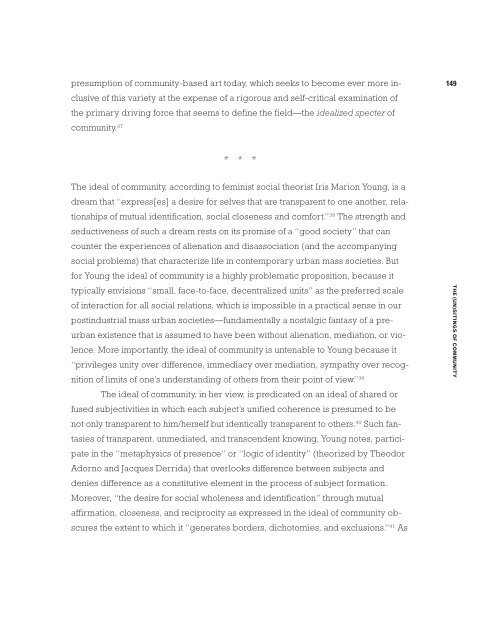ONE PLACE AFTER ANOTHER - Monoskop
ONE PLACE AFTER ANOTHER - Monoskop
ONE PLACE AFTER ANOTHER - Monoskop
Create successful ePaper yourself
Turn your PDF publications into a flip-book with our unique Google optimized e-Paper software.
presumption of community-based art today, which seeks to become ever more inclusive<br />
of this variety at the expense of a rigorous and self-critical examination of<br />
the primary driving force that seems to define the field—the idealized specter of<br />
community. 37<br />
* * *<br />
The ideal of community, according to feminist social theorist Iris Marion Young, is a<br />
dream that “express[es] a desire for selves that are transparent to one another, relationships<br />
of mutual identification, social closeness and comfort.” 38 The strength and<br />
seductiveness of such a dream rests on its promise of a “good society” that can<br />
counter the experiences of alienation and disassociation (and the accompanying<br />
social problems) that characterize life in contemporary urban mass societies. But<br />
for Young the ideal of community is a highly problematic proposition, because it<br />
typically envisions “small, face-to-face, decentralized units” as the preferred scale<br />
of interaction for all social relations, which is impossible in a practical sense in our<br />
postindustrial mass urban societies—fundamentally a nostalgic fantasy of a preurban<br />
existence that is assumed to have been without alienation, mediation, or violence.<br />
More importantly, the ideal of community is untenable to Young because it<br />
“privileges unity over difference, immediacy over mediation, sympathy over recognition<br />
of limits of one’s understanding of others from their point of view.” 39<br />
The ideal of community, in her view, is predicated on an ideal of shared or<br />
fused subjectivities in which each subject’s unified coherence is presumed to be<br />
not only transparent to him/herself but identically transparent to others. 40 Such fantasies<br />
of transparent, unmediated, and transcendent knowing, Young notes, participate<br />
in the “metaphysics of presence” or “logic of identity” (theorized by Theodor<br />
Adorno and Jacques Derrida) that overlooks difference between subjects and<br />
denies difference as a constitutive element in the process of subject formation.<br />
Moreover, “the desire for social wholeness and identification” through mutual<br />
affirmation, closeness, and reciprocity as expressed in the ideal of community obscures<br />
the extent to which it “generates borders, dichotomies, and exclusions.” 41 As<br />
149<br />
THE (UN)SITINGS OF COMMUNITY

















